Aesthetic Grounds: June 2007 Archives
As the super-connected and hyper-knowledged human planet moves forward in the last phase of geographic diversity, the analysis of any high culture specialty like visual art appears as useful as a pair of chopsticks. Most of the cultural activity generating and consuming the visual stuff just slides out of its grasp back into the bowl.
Public Art exists in a unique position outside the criticism of both the high art and the high design establishments and their historic traditions. Created mainly by people educated in universities, these artists quickly fall away from that high art dialogue and seek other kinds of visual, spatial and storytelling with connections to a much broader world.
What happens if we start to evaluate public art from these other traditions? And I don't mean some critic's "bone" toss and then back to the art point-of-view. Public art success might be based on these other traditions as well as the fine art one. Isn't every tradition "collectable" and loved?
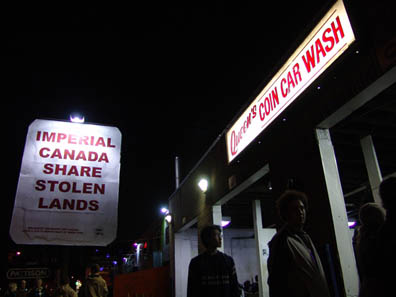
HOCK E AYE VI, Presence and Resistance, 2006, Photo: Miklos Legrady
Let's start with an easy one - public signs. Many artists utilize this tradition, but we could have picked gardens, cars, TVs, dolls, maps.............on and on and on. In this method, we need to set the stage for the other tradition first.
Today's general public (that is all of us) has a lifetime with public signs. We don't know urban space and life without them. We always have a "name" for where we are. Verification through the simultaneous appearance of place name and sign is psychologically expected. The lack of signs makes Havana a much stranger place than Times Square.
The other public signs provide non-geographic information. We read the public signs to learn something or think about something or re-live a feeling. (Yes, we take action and read, not merely mindless observation.) When in 2005 artists Rainer Dempf &
Christoph Steinbrener "yellowed-out" all the signs on an Austrian street, the visitor desperately attempted to read them any way.
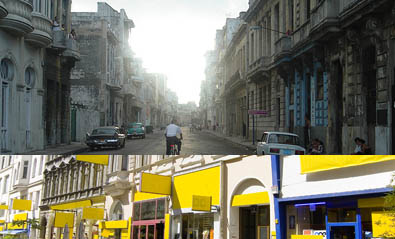
Havana photo by Pimpinela, "Delete" by Dempf & Steinbrener
The repetition of signs in a place can be a significant element of its visual character, especially at night as Jenny Holzer's work in San Diego. Or signs can be an intentional disruption of the character of place as Steinbrener & Dempf's fake Starbucks construction barricade entrance into a historic church.
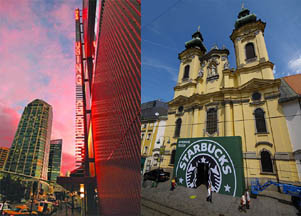
Holzer's "For MCASD", 2007 and Steinbrener & Dempf "Pass the Buck"
The signs can convey messages with new purposes such as Holzer's repetition of local narratives at the Pittsburgh Convention Center. But how successful is the work in comparison with her sign fabricator, Sunrise System, LED for FOA Schwartz. (How many of thought it was a Holzer?) At the top of the page, HOCK E AYE VI Edgar Heap-of-Birds sloganizes Native American outrages in the traditional space of a billboard. He is manipulating the message and accepts the urban form.
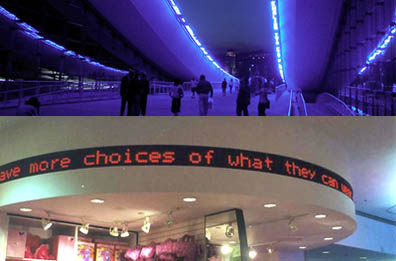
Holzer in Pittsburgh and Sunrise System in NYC
Of course, a love of the visual attributes of the signs can be the artist's apparent aim. Franck Scurti distorts the form of the pedestrian signs made from light boxes, neon tubes or awnings. Jack Pierson rearranges cheap discarded channel letters in an intuitive sense of a book cover designer. (Another tradition to explore.)
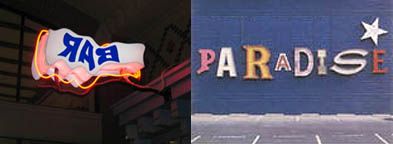
Scurti in France and Pierson at MOCA Miami (Photo- Jose Rodriguez)
Well I got to the end again. What have I learned? I think I learned that I understand these commonplace traditions of the street better than the art historical ones. There is more comfort in the local objects and spatial functions then engaging in a true art dialogue among artists and critics in the museum circuit. I like thinking about the physical world outdoors. Perhaps this is the source of critique for public art - a generator of thoughts and feelings about the common.
Sorry for my delay in blogging. Completing a large project or returning from an engrossing adventure always leads to a temporary depression. Suddenly everything is so calm without the adrenalin. The spirit drags and the imagination dissolves. This happens at least a twice a year for decades and I still respond the same. I learn nothing.
The trip to Turkey will be very influential to my thinking for two reasons.
1.) Turkey is a moving time machine. It is an example of the future, not the past. Remnants of time and people protrude into the contemporary space of Istanbul and the Aegean. A few hours of accidental strolling take you through Greek, Roman, Byzantine, Islamic and International spaces. With a little effort the Persians, the Lycians, The Hittites, Assyrians, the Apostles of Jesus and the Crusaders. Around another corner starts the collaboration with Europe in 19th Century and 20th century architecture, design and art. If your tired, grab the sleek tram or subway back across the same history. I think Istanbul offers a fresh way into globalism.
2. The book "My Name is Red" by Orhan Pamuk. Through the detective story, Pamuk ruminates of the value of miniature painting during the challenge of Italian realism of the 16th century. I will be bringing the book forward in little pieces as I question my understanding of cultural expression verses individual expression. If relevant, I will include a quote in my various entries. Today for Richard Wilson, I quote a master miniaturist: "Painting brings to life what the mind sees, as a feast for the eyes."
In Liverpool, England, sculptor Richard Wilson has created a new temporary public artwork called "Turning the Place Over." On a building to be demolished, Wilson has caused an 8-meter section of exterior wall to rotate in and out of the façade. The geometry of the rotation is complex and therefore the video is the only way for the virtual traveler to know a little of the work.
Video by Nudelita on YouTube
"Painting brings to life what the mind sees, as a feast for the eyes." The work is definitely a meal, but I don't think a feast. No pedestrian could resist a viewing of the breaking from and re-melding with the building surface. The twisting of the cutout in the plane of the building does not quite seems possible. But just public notice (a success in some ways) does not equal public art success.
What does Wilson's mind see? Pamuk's miniaturist is not interested in Wilson's personal mental observation but the common mind that has found expression through centuries of art. Art shapes what the mind sees.
Below is a not-so-arbitrary selection a series of art images that shape the common attributes of my mind regarding broken holes or the moving plates in buildings. Many more are possible such as a slow motion version of missile attack that is repeating endlessly on every television channel or radar stations or cartoon impossibilities or many architects that design holes in buildings and roofs.
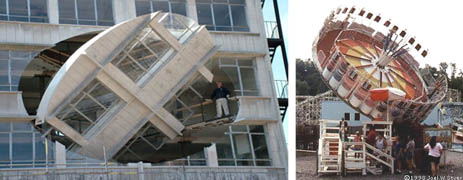
At least Americans have been watching this size tilting and rotating plate at county fairgrounds during most of the 20th century. Wilson selects a size that has been experienced by most observers. The observer "feels" the tilt.
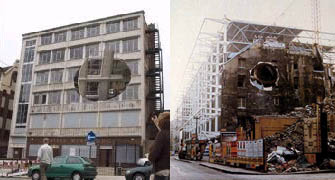
Gordon Matta-Clark cut an invisible cone into the soon-to-be-demolished Parisian building in 1975. Urban art can be made by removal, not addition.
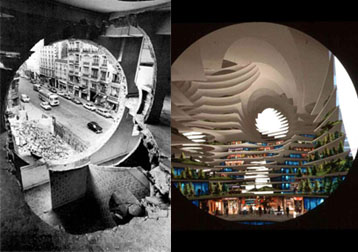
Vito Acconci's World Trade Center site tower constructs Matta-Clark's destructive removal as a positive, not a negative. Carving out is a part of building up.
In Munich "Courtyard in the Wind", Acconci shifts the earth in a fashion like Wilson's façade in that the circular motion breaks from and then returns to design of plane.
The human tolerance for this notion of false ground - moved and placed anywhere - is highlighted during the 2005 Federer and Agassi tennis game on the heliport at the Burj Al Arab Hotel in Dubai design by Aktins Global.
So what is in the common mind of this writer? Or perhaps a better question for the moment, what is seen in the mind's eye that is being repeated. The mind's eye sees all human creation as insubstantial and that substantiality is a perceptual trick of our most substantial thing: architecture. The circle illustrates the insubstantial with its potential for motion and its lack of solid connection to other parts.
So we have a "history" that is not known by anyone passing on the street in Liverpool. Yet the British walkers might know that anything unusual and not seen before might be the work of an artist or a promoter. No words, then most likely art
Blogroll
AJ Ads
AJ Blogs
AJBlogCentral | rssculture
Terry Teachout on the arts in New York City
Andrew Taylor on the business of arts & culture
rock culture approximately
Laura Collins-Hughes on arts, culture and coverage
Richard Kessler on arts education
Douglas McLennan's blog
Dalouge Smith advocates for the Arts
Art from the American Outback
For immediate release: the arts are marketable
No genre is the new genre
David Jays on theatre and dance
Paul Levy measures the Angles
Judith H. Dobrzynski on Culture
John Rockwell on the arts
Jan Herman - arts, media & culture with 'tude
dance
Apollinaire Scherr talks about dance
Tobi Tobias on dance et al...
jazz
Howard Mandel's freelance Urban Improvisation
Focus on New Orleans. Jazz and Other Sounds
Doug Ramsey on Jazz and other matters...
media
Jeff Weinstein's Cultural Mixology
Martha Bayles on Film...
classical music
Fresh ideas on building arts communities
Greg Sandow performs a book-in-progress
Exploring Orchestras w/ Henry Fogel
Harvey Sachs on music, and various digressions
Bruce Brubaker on all things Piano
Kyle Gann on music after the fact
Greg Sandow on the future of Classical Music
Norman Lebrecht on Shifting Sound Worlds
publishing
Jerome Weeks on Books
Scott McLemee on books, ideas & trash-culture ephemera
theatre
Wendy Rosenfield: covering drama, onstage and off
Chloe Veltman on how culture will save the world
visual
Public Art, Public Space
Regina Hackett takes her Art To Go
John Perreault's art diary
Lee Rosenbaum's Cultural Commentary
Tyler Green's modern & contemporary art blog
